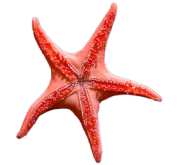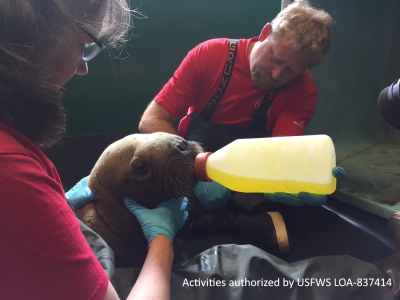ASLC is rehabilitating a male Pacific walrus calf that stranded near Nome, Alaska on Wednesday, June 14 June 20, 2017
Seward, AK (June 19, 2017) –The Alaska SeaLife Center (ASLC) is rehabilitating a male Pacific walrus calf that stranded near Nome, Alaska on Wednesday, June 14.
The calf, estimated to be about 2 weeks old and weighing 55 kg (120 pounds), hauled out onto a gold mining barge several miles outside of Nome. The crew returned to Nome for the night and crew found the animal was still on board the next day.
The Alaska SeaLife Center received a call to its Stranding Hotline the afternoon of Friday, June 16. ASLC contacted local responder Gay Sheffield, Marine Advisory Program agent for Alaska Sea Grant in Nome. While Sheffield immediately prepared to receive the animal, ASLC worked with Northern Air Cargo (NAC) to plan transportation from Nome to Anchorage.
The walrus calf was subsequently flown by NAC to Anchorage, arriving before noon on Saturday, June 17. Meeting the airplane were Dr. Carrie Goertz, ASLC staff veterinarian, and husbandry director Brett Long. They conducted a brief health assessment and transported the calf to the Center’s I.Sea.U rehabilitation facility arriving at 3 p.m. The calf appears to be in stable condition; however, Center veterinarians are addressing some health concerns while performing additional diagnostic testing to better understand his condition. In the short-term veterinarians have prescribed a care regime with continued emphasis on hydration and round-the clock tube feedings.
“We are in the very early stages of treating this animal but we are cautiously optimistic,” said Dr. Carrie Goertz, ASLC staff veterinarian. “Walrus are incredibly tactile, social animals. Calves typically spend about two years with their mothers, so we have to step in to provide that substitute care and companionship. This includes round-the-clock physical contact and care from staff.” Due to the high level of maternal investment in the wild, walrus calves are not candidates for release following rehabilitation.
Physically separated from the other established stranding areas at the Center, the I.Sea.U is the Center’s largest quarantine area which makes it particularly well suited for animals such as walrus. It includes a custom designed pool with self-contained life support systems for water inflow and filtration; and self-contained showering and dressing areas for staff who must adhere to tighter shower and clothing-change protocols when entering and exiting the unit. Visitors to the Center can overlook the activities in the I.Sea.U through windows near the touch tank.
The Alaska SeaLife Center, a non-profit 501(c)(3) organization, is the only permitted marine mammal wildlife response and rehabilitation entity in Alaska. Over 80% of the funding for the Center’s wildlife response program comes from charitable contributions. “We especially thank individual Alaskans all across the state, our visitors and corporate sponsors at BP Alaska, ConocoPhillips, PetZoo and GCI for their generous contributions to the Center in support of wildlife rescue,” said Tara Riemer, ASLC President and CEO.
The Alaska SeaLife Center operates a 24-hour hotline for the public to report stranded marine mammals or birds,and encourages people whohave found a stranded or sick marine animal to avoid touching or approaching the animal. Call first! 1-888-774-SEAL.


